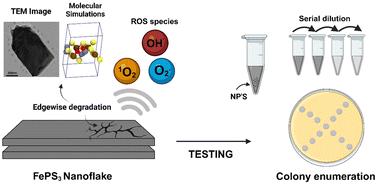Our official English website, www.x-mol.net, welcomes your
feedback! (Note: you will need to create a separate account there.)
2-D transition metal trichalcophosphogenide FePS3 against multi-drug resistant microbial infections
Nanoscale ( IF 5.8 ) Pub Date : 2024-11-04 , DOI: 10.1039/d4nr03409k Shreehari Kodakkat, Pierre H. A. Valliant, Serena Ch'ng, Z. L. Shaw, Miyah Naim Awad, Billy J. Murdoch, Andrew J. Christofferson, Saffron J. Bryant, Sumeet Walia, Aaron Elbourne
Nanoscale ( IF 5.8 ) Pub Date : 2024-11-04 , DOI: 10.1039/d4nr03409k Shreehari Kodakkat, Pierre H. A. Valliant, Serena Ch'ng, Z. L. Shaw, Miyah Naim Awad, Billy J. Murdoch, Andrew J. Christofferson, Saffron J. Bryant, Sumeet Walia, Aaron Elbourne

|
Antimicrobial resistance (AMR) is a significant concern to society as it threatens the effectiveness of antibiotics and leads to increased morbidity and mortality rates. Innovative approaches are urgently required to address this challenge. Among promising solutions, two dimensional (2-D) nanomaterials with layered crystal structures have emerged as potent antimicrobial agents owing to their unique physicochemical properties. This antimicrobial activity is largely attributed to their high surface area, which allows for efficient interaction with microbial cell membranes, leading to physical disruption or oxidative stress through the generation of reactive oxygen species (ROS). The latter mechanism is particularly noteworthy as it involves the degradation of these nanomaterials under specific conditions, releasing ROS that can effectively kill bacteria and other pathogens without harming human cells. This study explores the antimicrobial properties of a novel biodegradable nanomaterial based on 2-D transition metal trichalcogenides, FePS3, as a potential solution to drug-resistant microbes. Our findings indicate that FePS3 is an exceptionally effective antimicrobial agent with over 99.9% elimination of various bacterial strains. Crucially, it exhibits no cytotoxic effects on mammalian cells, underscoring the potential for safe biomedical application. The primary mechanism driving the antimicrobial efficacy of FePS3 is the release of ROS during biodegradation. ROS has a crucial role in neutralizing bacterial cells, conferring significant antipathogenic properties to this compound. The unique combination of high antimicrobial activity, biocompatibility, and biodegradability makes FePS3 a promising candidate for developing new antimicrobial strategies. This research contributes to the increasing body of evidence supporting the use of 2-D nanomaterials in addressing the global challenge of AMR, offering a potential pathway for the development of advanced, effective, and safe antimicrobial agents.
中文翻译:

2-D 过渡金属三氢磷化物 FePS3 对抗多重耐药微生物感染
抗菌素耐药性 (AMR) 是社会的一个重大问题,因为它威胁到抗生素的有效性并导致发病率和死亡率增加。迫切需要创新方法来应对这一挑战。在有前途的解决方案中,具有层状晶体结构的二维 (2-D) 纳米材料由于其独特的物理化学特性而成为有效的抗菌剂。这种抗菌活性主要归因于它们的高表面积,这允许与微生物细胞膜有效相互作用,通过产生活性氧 (ROS) 导致物理破坏或氧化应激。后一种机制特别值得注意,因为它涉及这些纳米材料在特定条件下的降解,释放出可以有效杀死细菌和其他病原体而不伤害人体细胞的 ROS。本研究探讨了一种基于 2-D 过渡金属三硫化物 FePS3 的新型可生物降解纳米材料的抗菌特性,作为耐药微生物的潜在解决方案。我们的研究结果表明,FePS3 是一种非常有效的抗菌剂,可消除超过 99.9% 的各种细菌菌株。至关重要的是,它对哺乳动物细胞没有细胞毒性作用,强调了安全生物医学应用的潜力。驱动 FePS3 抗菌功效的主要机制是生物降解过程中 ROS 的释放。ROS 在中和细菌细胞中起着至关重要的作用,赋予该化合物显着的抗病原特性。 高抗菌活性、生物相容性和生物降解性的独特组合使 FePS3 成为开发新抗菌策略的有前途的候选者。这项研究有助于越来越多的证据支持使用 2-D 纳米材料来应对 AMR 的全球挑战,为开发先进、有效和安全的抗菌剂提供了一条潜在的途径。
更新日期:2024-11-04
中文翻译:

2-D 过渡金属三氢磷化物 FePS3 对抗多重耐药微生物感染
抗菌素耐药性 (AMR) 是社会的一个重大问题,因为它威胁到抗生素的有效性并导致发病率和死亡率增加。迫切需要创新方法来应对这一挑战。在有前途的解决方案中,具有层状晶体结构的二维 (2-D) 纳米材料由于其独特的物理化学特性而成为有效的抗菌剂。这种抗菌活性主要归因于它们的高表面积,这允许与微生物细胞膜有效相互作用,通过产生活性氧 (ROS) 导致物理破坏或氧化应激。后一种机制特别值得注意,因为它涉及这些纳米材料在特定条件下的降解,释放出可以有效杀死细菌和其他病原体而不伤害人体细胞的 ROS。本研究探讨了一种基于 2-D 过渡金属三硫化物 FePS3 的新型可生物降解纳米材料的抗菌特性,作为耐药微生物的潜在解决方案。我们的研究结果表明,FePS3 是一种非常有效的抗菌剂,可消除超过 99.9% 的各种细菌菌株。至关重要的是,它对哺乳动物细胞没有细胞毒性作用,强调了安全生物医学应用的潜力。驱动 FePS3 抗菌功效的主要机制是生物降解过程中 ROS 的释放。ROS 在中和细菌细胞中起着至关重要的作用,赋予该化合物显着的抗病原特性。 高抗菌活性、生物相容性和生物降解性的独特组合使 FePS3 成为开发新抗菌策略的有前途的候选者。这项研究有助于越来越多的证据支持使用 2-D 纳米材料来应对 AMR 的全球挑战,为开发先进、有效和安全的抗菌剂提供了一条潜在的途径。


















































 京公网安备 11010802027423号
京公网安备 11010802027423号